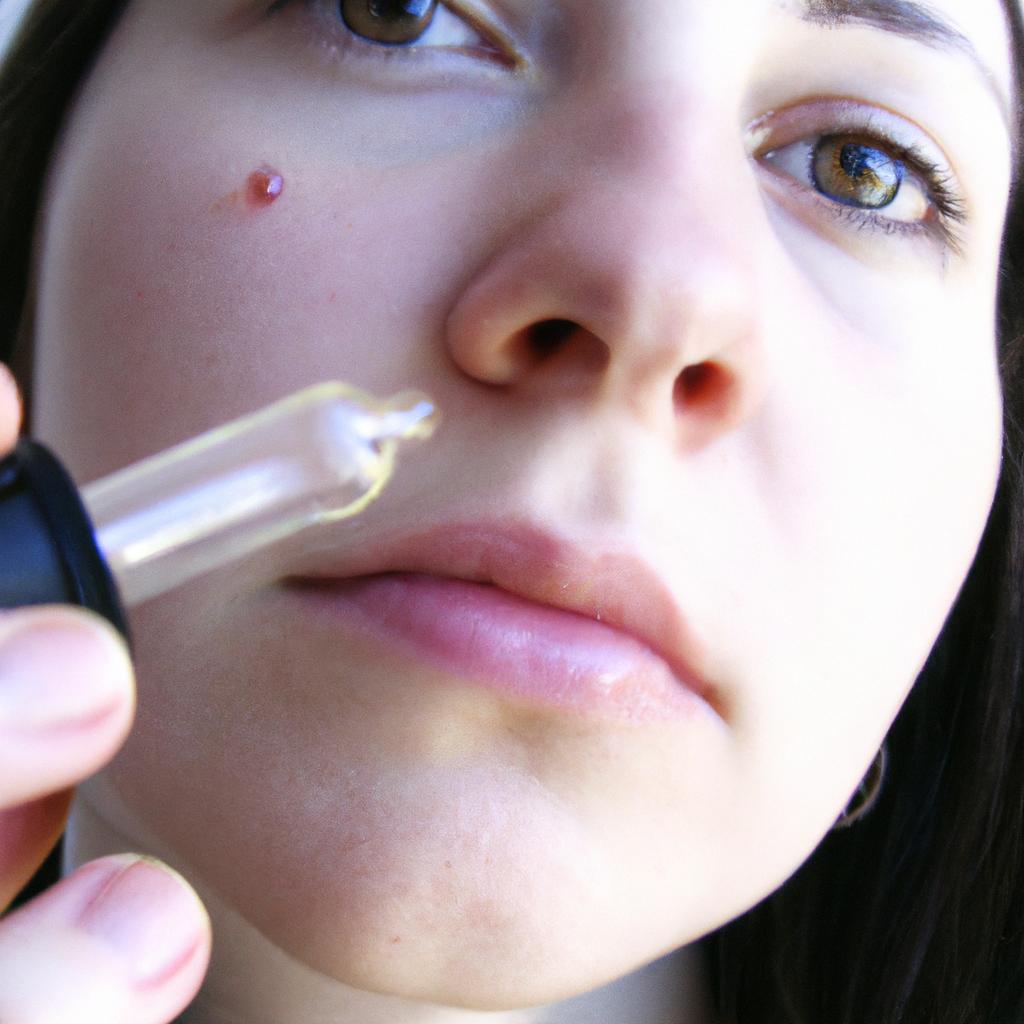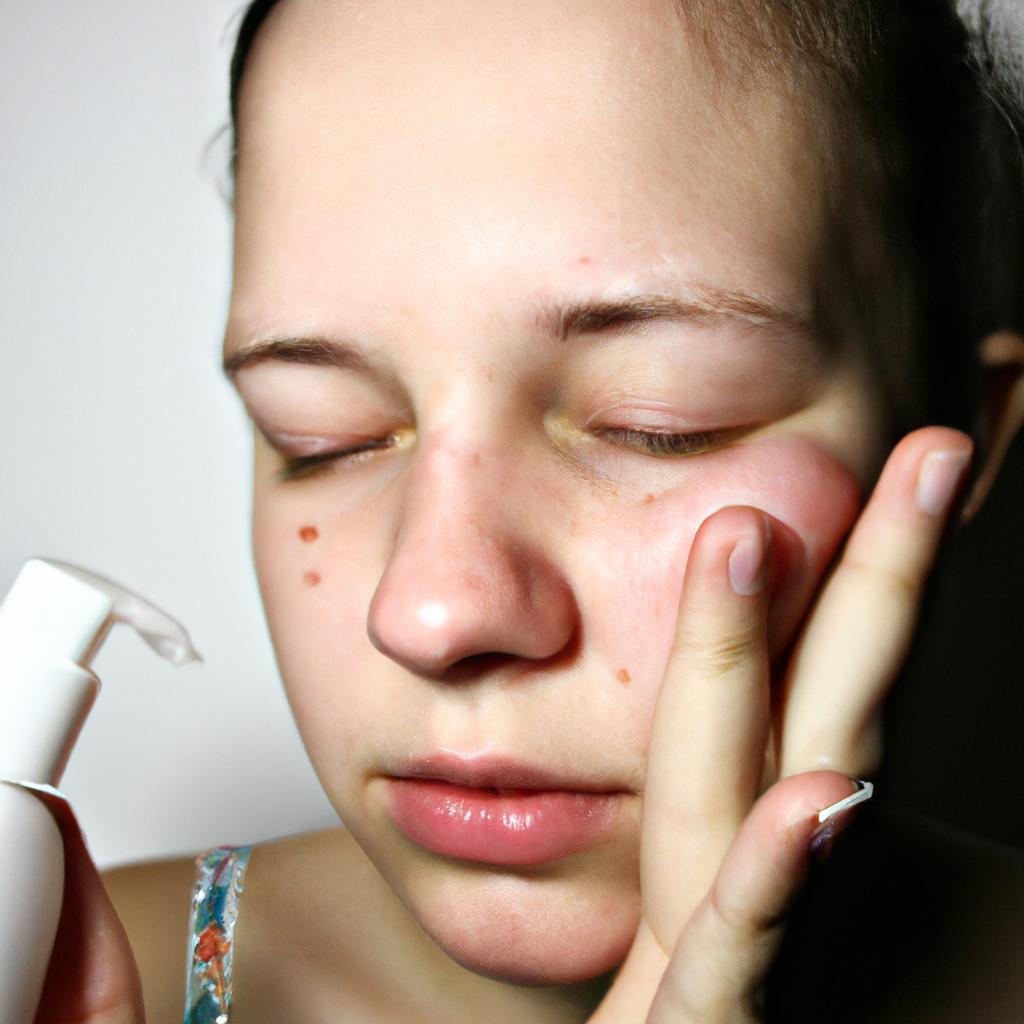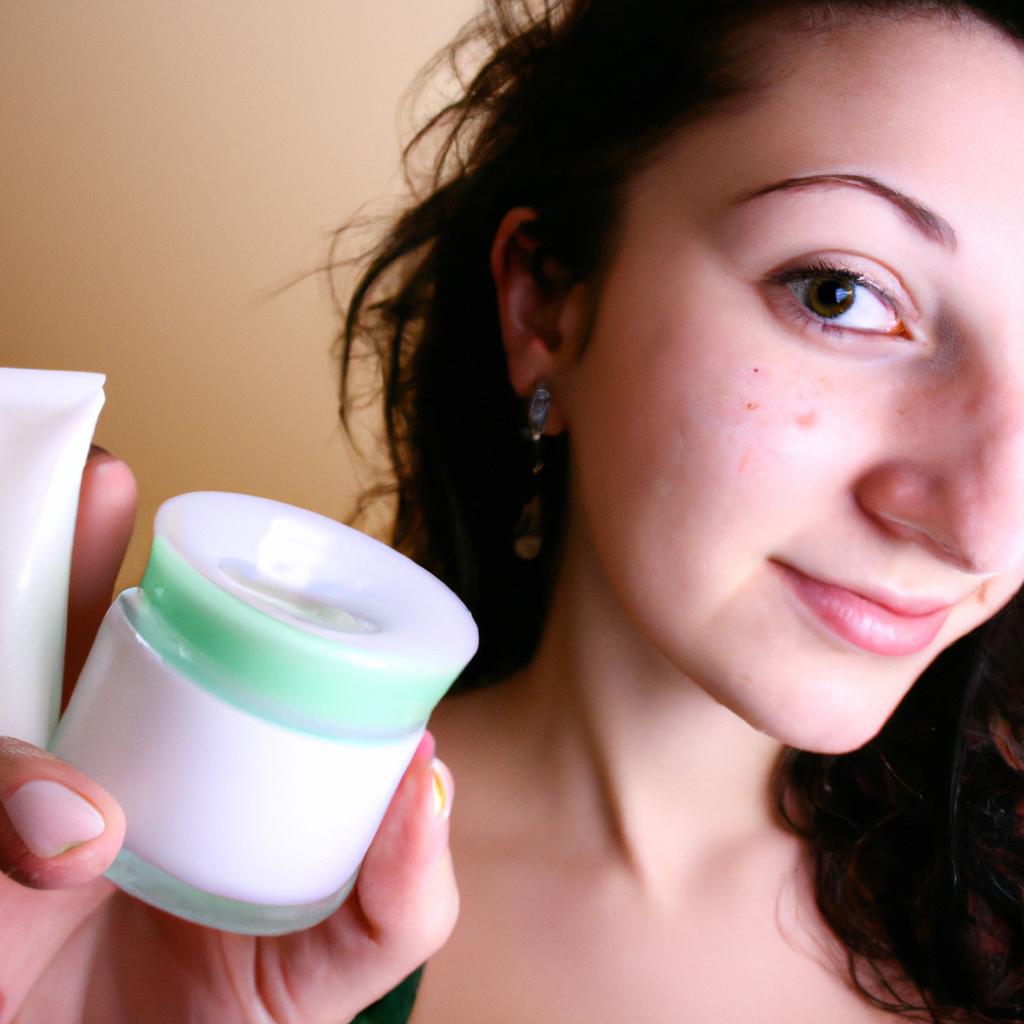Exfoliation is a vital step in any skincare routine, as it helps to remove dead skin cells and unclog pores, resulting in smoother and healthier-looking skin. By incorporating an exfoliator into your skincare regimen, you can enhance the effectiveness of other products, such as moisturizers and serums, by allowing them to penetrate deeper into the skin. In this article, we will explore the significance of exfoliation in achieving optimal skin health and discuss various types of exfoliators available on the market.
Imagine a scenario where an individual diligently follows their usual skincare routine consisting of cleansing, toning, and moisturizing but still struggles with dullness and uneven texture on their face. Despite using quality skincare products, they find themselves dissatisfied with the lackluster results obtained. This situation emphasizes the importance of including an exfoliator in one’s skincare arsenal. Exfoliation acts as a catalyst for rejuvenating the skin by sloughing off dead cells that accumulate on its surface over time.
Understanding the benefits of exfoliation
Imagine a scenario where you wake up in the morning, look into the mirror, and notice dull, lifeless skin staring back at you. You might wonder how to revive its natural radiance and achieve a healthy complexion. This is where exfoliation comes into play – an essential step in any skincare routine that offers numerous benefits for your skin’s overall health and appearance.
Exfoliation involves removing dead skin cells from the surface of your skin, revealing fresh, rejuvenated skin underneath. By incorporating this simple yet effective technique into your skincare regimen, you can experience several advantages:
- Enhanced Skin Texture: Regular exfoliation helps smoothen rough patches on your skin, giving it a softer and more refined texture.
- Improved Skin Tone: Exfoliating eliminates built-up dead cells that can contribute to an uneven complexion. It promotes even distribution of melanin, resulting in a brighter and more balanced skin tone.
- Reduced Acne Breakouts: The removal of dead cells prevents clogged pores and reduces the likelihood of acne breakouts. It also aids in controlling excess oil production.
- Increased Absorption: When dead cells are removed, serums, moisturizers, and other products penetrate deeper into the skin, allowing them to be absorbed more effectively.
To further understand these benefits visually, consider the following table:
| Benefit | Description |
|---|---|
| Enhanced Skin Texture | Smoothes rough patches |
| Improved Skin Tone | Evens out complexion |
| Reduced Acne Breakouts | Prevents clogged pores; controls excess oil |
| Increased Absorption | Enhances penetration of skincare products |
In conclusion,
Understanding the importance of exfoliation is crucial for achieving healthier-looking skin. By regularly incorporating this step into your skincare routine, you can enjoy smoother texture, improved skin tone, reduced acne breakouts, and increased absorption of skincare products. In the following section, we will explore different types of exfoliators and their usage to help you choose the most suitable option for your needs.
Different types of exfoliators and their usage
Understanding the benefits of exfoliation:
Exfoliating your skin regularly can bring about numerous benefits. Not only does it help to remove dead skin cells, but it also promotes cell turnover and reveals a fresh, radiant complexion. Let’s take a closer look at some key advantages of incorporating exfoliation into your skincare routine.
One significant benefit is that exfoliation can improve the effectiveness of other skincare products you use. By removing the buildup of dead skin cells, exfoliators allow serums, moisturizers, and masks to penetrate deeper into the skin. This leads to better absorption of active ingredients and maximizes their potential benefits.
Additionally, regular exfoliation can help reduce breakouts and prevent clogged pores. Dead skin cells can accumulate on the surface of your skin, mixing with excess sebum and pollutants. This combination can lead to blocked pores, causing acne or blackheads. By gently scrubbing away these impurities, exfoliators promote clearer skin and minimize the risk of future breakouts.
Exfoliating also helps in improving uneven skin tone and texture. It smoothes out rough patches and diminishes fine lines by stimulating collagen production. As a result, dullness is replaced with a more youthful appearance over time.
To illustrate further how beneficial exfoliation can be for your skin care routine, consider this hypothetical scenario:
- Sarah had been struggling with dry and flaky patches on her cheeks despite using various moisturizing creams. After incorporating an exfoliator into her regimen twice a week for a month, she noticed significant improvement in her skin’s hydration levels as well as overall smoothness.
The emotional response evoked from understanding these benefits include feelings such as excitement about achieving healthier-looking skin, relief from persistent dryness or breakout concerns, confidence gained from improved complexion quality, and satisfaction knowing that one’s skincare products will work optimally when used alongside regular exfoliation.
Here are some additional reasons why exfoliation is beneficial:
- It helps to remove excess oil and unclog pores, reducing the occurrence of acne.
- By stimulating blood circulation, it gives your skin a healthy glow.
- Exfoliating can help fade dark spots or hyperpigmentation over time.
- Regular exfoliation aids in preventing ingrown hairs after shaving.
To further explore these benefits and understand how different types of exfoliators should be used according to individual needs, let’s move on to the next section.
How often should you exfoliate?
Exfoliating your skin can provide numerous benefits, such as removing dead skin cells and revealing a fresh, radiant complexion. However, it is important to find the right balance when incorporating exfoliation into your skincare routine. The frequency of exfoliation depends on several factors, including skin type and sensitivity.
Consider the following scenario: Sarah has dry, sensitive skin that tends to become easily irritated. She decides to incorporate an exfoliator into her skincare routine in order to improve her skin’s texture and appearance.
When determining how often to exfoliate, it is crucial to listen to your skin and adjust accordingly. Here are some general guidelines:
- Normal or Combination Skin: If you have normal or combination skin, experts recommend exfoliating 2-3 times per week for optimal results.
- Oily Skin: Those with oily skin may benefit from exfoliating more frequently, around 3-4 times per week. This helps remove excess oil and unclog pores.
- Dry or Sensitive Skin: Individuals with dry or sensitive skin should approach exfoliation with caution. It is advisable to limit exfoliation to once a week or even less frequently if any signs of irritation occur.
- Acne-prone Skin: For those dealing with acne-prone skin, regular exfoliation can be beneficial in preventing clogged pores and reducing breakouts. Aim for 2-3 times per week using gentle exfoliators specifically formulated for acne-prone skin.
| Normal/Combination Skin | Oily Skin | Dry/Sensitive Skin | Acne-Prone Skin | |
|---|---|---|---|---|
| Frequency | 2-3 times per week | 3-4 times per week | Once a week or less | 2-3 times per week |
It is essential to remember that these guidelines serve as a starting point, and individual preferences and skin reactions should be taken into account. Over-exfoliating can lead to irritation, redness, and dryness. On the other hand, under-exfoliating may not provide desired results. Find the right balance by paying attention to your skin’s response.
In the subsequent section about “Precautions to take while using exfoliators,” we will discuss important measures you should consider when incorporating exfoliation into your skincare routine in order to ensure safe and effective use of exfoliators.
Precautions to take while using exfoliators
Enhancing Your Skin Care Routine: Precautions to Take While Using Exfoliators
Exfoliation is an essential step in any skincare routine, helping to remove dead skin cells and reveal a smoother complexion. However, it is crucial to approach exfoliation with caution to avoid potential side effects or damage to the skin. By taking certain precautions, you can ensure that your exfoliation experience is safe and effective.
One important precaution when using exfoliators is to be mindful of how often you exfoliate. Over-exfoliating can lead to skin irritation, dryness, and even breakouts. It is generally recommended to exfoliate no more than twice a week for normal skin types. However, if you have sensitive or acne-prone skin, it may be best to limit exfoliation to once a week or consult with a dermatologist for personalized advice.
Additionally, always choose the right type of exfoliator for your skin’s needs. There are two main categories of exfoliants: physical and chemical. Physical exfoliants typically use ingredients like granules or brushes to physically scrub away dead skin cells. Chemical exfoliants work by dissolving the bonds between cells using ingredients such as alpha-hydroxy acids (AHAs) or beta-hydroxy acids (BHAs). Consider your specific skin concerns and sensitivity when selecting an appropriate option.
To further enhance your understanding of precautions while using exfoliators, let us consider some key points:
- Always perform a patch test before incorporating a new product into your routine.
- Avoid over-scrubbing or applying too much pressure during physical exfoliation.
- Be cautious when combining multiple active ingredients in your skincare regimen.
- Moisturize adequately after each session of exfoliation to restore hydration levels.
Incorporating these precautions will help minimize the risk of adverse reactions and maximize the benefits of regular exfoliation.
Now that you are familiar with the precautions to take while using exfoliators, let us explore how you can effectively incorporate exfoliation into your skincare regimen. By following these guidelines and understanding the importance of proper exfoliation techniques, you can achieve a healthier and more radiant complexion.
Incorporating exfoliation into your skincare regimen
Case Study:
Imagine Sarah, a busy working professional in her thirties. She has recently noticed dullness and uneven texture on her skin due to stress and lack of sleep. Seeking a solution, she decides to incorporate exfoliation into her skincare routine.
To successfully integrate exfoliation into your regimen, consider the following steps:
-
Frequency: Determine how often you should exfoliate based on your skin type and sensitivity. Generally, it is recommended to exfoliate 1-2 times per week for normal or combination skin, while sensitive or dry skin may benefit from less frequent exfoliation.
-
Product Selection: Choose an exfoliator that suits your specific needs. There are two main types: physical (scrubs, brushes) and chemical (alpha hydroxy acids, beta hydroxy acids). Each option works differently to remove dead skin cells and unclog pores.
-
Patch Test: Before applying any new product all over your face, perform a patch test on a small area of your skin to ensure compatibility and avoid potential adverse reactions such as redness or irritation.
-
Application Technique: When using physical exfoliators like scrubs or brushes, apply gentle pressure in circular motions to avoid damaging the delicate facial skin. For chemical exfoliants such as toners or serums containing AHA/BHA, follow the instructions provided by the manufacturer carefully.
Table – Benefits of Regular Exfoliation
| Benefit | Description |
|---|---|
| Smoother Skin | Removes dead skin cells for a smoother texture |
| Enhanced Radiance | Reveals brighter complexion beneath the outer layer |
| Reduced Acne | Helps unclog pores and reduce breakouts |
| Improved Absorption | Allows better penetration of other skincare products |
By incorporating regular exfoliation into your skincare routine, you can reap the benefits mentioned above. However, remember that over-exfoliation can lead to skin irritation and disruption of its natural barrier function. Therefore, it is crucial to strike a balance and listen to your skin’s needs.
As you embark on the journey to achieve healthier skin through exfoliation, let’s explore some tips for choosing the right exfoliator for your specific skin type.
Tips for choosing the right exfoliator for your skin type
Incorporating exfoliation into your skincare regimen can provide numerous benefits for the health and appearance of your skin. By removing dead skin cells, exfoliation promotes cell turnover, revealing a smoother and more radiant complexion. Moreover, regular exfoliation can help unclog pores, prevent acne breakouts, reduce the appearance of fine lines and wrinkles, and even promote better absorption of skincare products.
For instance, let’s consider Emily, who struggled with dull and congested skin. After incorporating exfoliation into her skincare routine twice a week using a gentle scrub containing natural ingredients like jojoba beads and fruit enzymes, she noticed remarkable improvements in her complexion. Her skin appeared brighter, felt softer to touch, and she experienced fewer breakouts as well.
To choose the right exfoliator for your specific skin type and concerns, it is important to consider certain factors. Here are some tips to keep in mind:
- Skin Sensitivity: If you have sensitive or easily irritated skin, opt for chemical exfoliants such as AHAs (alpha hydroxy acids) or BHAs (beta hydroxy acids), rather than physical scrubs that may cause abrasion.
- Acne-prone Skin: Look for exfoliators containing salicylic acid or tea tree oil as they possess anti-inflammatory properties that can help control acne.
- Dry Skin: Consider using an exfoliator with moisturizing ingredients like hyaluronic acid or glycerin to prevent excessive dryness after exfoliation.
- Aging Skin: Opt for exfoliators with antioxidants like vitamin C or retinol which can help improve collagen production and minimize signs of aging.
- Achieve a vibrant glow
- Experience smoother texture
- Minimize clogged pores
- Enhance overall radiance
Table demonstrating different types of exfoliators:
| Exfoliator Type | Key Ingredient(s) | Benefits |
|---|---|---|
| Physical Scrubs | Jojoba beads, | Smoothing rough texture |
| fruit enzymes | and improving skin tone | |
| Chemical Exfoliants | AHAs (e.g., | Gentle exfoliation for |
| (AHAs, BHAs) | glycolic acid), | sensitive or acne-prone skin |
| BHAs (e.g., | ||
| salicylic acid) |
Incorporating the right exfoliator into your skincare routine can truly transform the health and appearance of your skin. By considering your specific needs and preferences, you can find an exfoliator that suits your skin type and helps you achieve a more radiant complexion. Remember to start slowly with exfoliation, gradually increasing frequency as your skin adjusts, and always follow up with appropriate moisturization and sun protection.
 Stanley Beauty Care
Stanley Beauty Care



